Archive
- Behind the Screens 9
- Bright Young Things 16
- Colour Palette 64
- Dress Ups 60
- Fashionisms 25
- Fashionistamatics 107
- Foreign Exchange 13
- From the Pages of… 81
- G.U.I.L.T. 10
- Little Trifles 126
- Lost and Found 89
- Odd Socks 130
- Out of the Album 39
- Red Carpet 3
- Silver Screen Style 33
- Sit Like a Lady! 29
- Spin, Flip, Click 34
- Vintage Rescue 20
- Vintage Style 157
- Wardrobe 101 148
- What I Actually Wore 163
Delicious Apricot
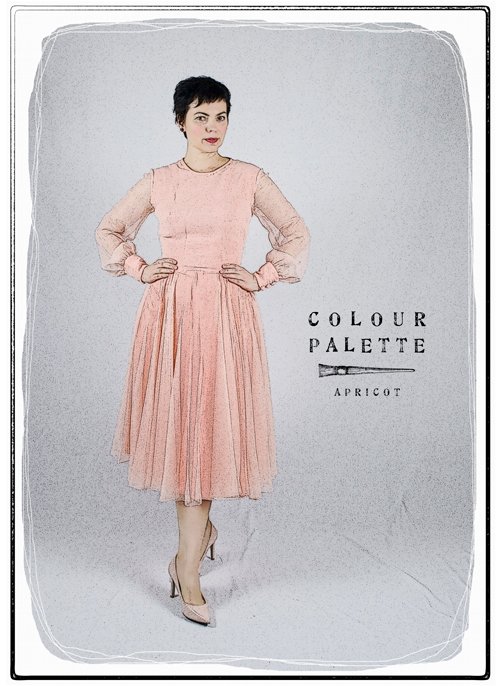 You will not be surprised to read that the colour apricot, like orange, takes its name from the fruit. The word first used in English to describe the fruit was abrecock, from Middle French, but it was not used to describe the colour until 1851.
You will not be surprised to read that the colour apricot, like orange, takes its name from the fruit. The word first used in English to describe the fruit was abrecock, from Middle French, but it was not used to describe the colour until 1851.
Orange, on the other hand has been around for a little longer, first coming into use three centuries earlier. But before the descriptor ‘orange’, such shades were described by English speakers as giolureade – ‘yellow-red’*.
 Apricots and agate
Apricots and agate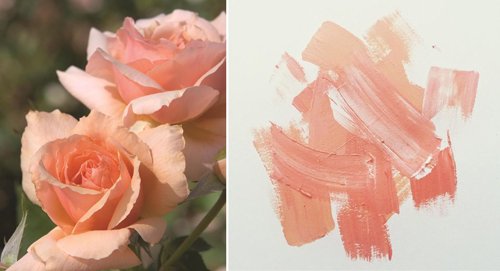 ‘Apricot Candy’ rose, and paint swatches
‘Apricot Candy’ rose, and paint swatches Four different swatches for the colour apricot found in Google Images
Four different swatches for the colour apricot found in Google Images
Imagine then having to describe pale yellow-red! It’s no surprise that so many colours are simply named after an object – the only problem is that such things can vary in tone. Apricot is no exception – the fruit is variegated, and there are many variations of swatches available, but the shade is generally accepted to be much paler than the actual fruit. It is more yellow in tone than its sister shade, peach.
Apricot is a colour that I have never liked. In fact, the original concept of this story was ‘colours I hate’! For me, as I imagine for many others, it has always had connotations with bland, sickly 1980s interior décor (see below). Hideous – like a nightmare you couldn't wake from.
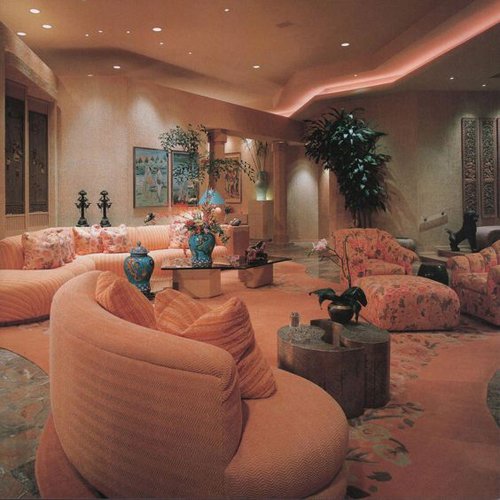 80s apricot interior design But a funny thing happened one day when I was browsing in a vintage bazaar with a friend. We conceived the humorous plan to each find the ugliest dress we possibly could, and try it on for a laugh. The chiffon apricot 70s dress is what I pulled out of the racks.
80s apricot interior design But a funny thing happened one day when I was browsing in a vintage bazaar with a friend. We conceived the humorous plan to each find the ugliest dress we possibly could, and try it on for a laugh. The chiffon apricot 70s dress is what I pulled out of the racks.
Unexpectedly however, once I had put it on, preened in front of the mirror and done a few twirls, it began to grow on me. Even my friend protested that I had chosen a dress that was not nearly as ugly as the one she had picked out (see below).
 My friend Sapphire and I try on some 80s dresses in a vintage bazaar in Geelong
My friend Sapphire and I try on some 80s dresses in a vintage bazaar in Geelong
The dress – the label declared it was by Elegance, which I have never seen before – was inexpensive, so whimsically I decided to buy it. I have even actually worn it out to an Opening Night at the theatre, with my pink Victorian cloak.
If you have light skin, there is a risk of looking naked wearing apricot and other such shades (who can forget Carrie and her ’naked dress’ in that episode of Sex and the City?), but there is no danger of that in this dress with its billowing sleeves and skirt. The dress has belt loops which are sadly bereft – I imagine it once had an extravagant sash.
 These sweet and pale tones were favoured in the 1920s to the 1940s for women’s lingerie – in such use, made from georgette, chiffon and satin and trimmed in pretty lace, were apricot and peach at the height of their powers. Delicious!
These sweet and pale tones were favoured in the 1920s to the 1940s for women’s lingerie – in such use, made from georgette, chiffon and satin and trimmed in pretty lace, were apricot and peach at the height of their powers. Delicious!
The colour has been seen in fashion since of course, especially in the 80s, when pastels, and brasher shades of coral and watermelon were the rage. It’s akin to Pantone’s 2019 Colour of the Year, Living Coral, and is already popular in interior design, so I wouldn’t be surprised to see a renaissance of full-blown apricot-hued revival soon. I bet you can’t wait!
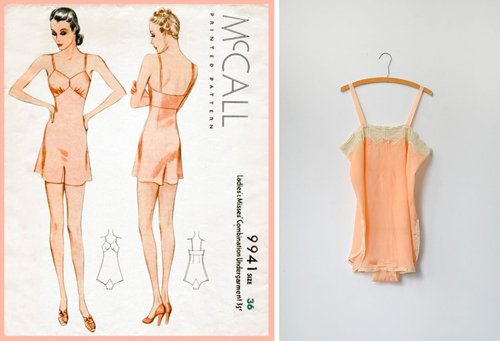 1930s lingerie
1930s lingerie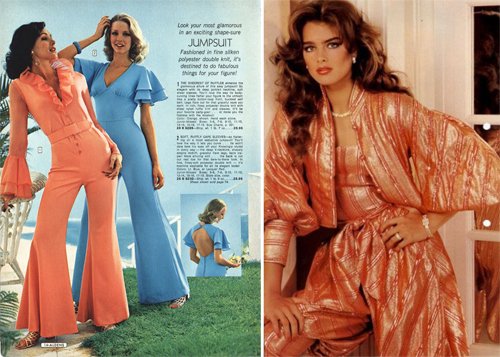 1970s jumpsuits, Brooke Shields in the 80s
1970s jumpsuits, Brooke Shields in the 80s
*From The Secret Lives of Colour, by Kassia St Clair, John Murray 2016)
Images found on Pinterest
Photos: March 2017
Stocking Stuff
 Recently I found a stack of 1960s vintage stockings in a thrift store, which was a fun and thrilling find that had more to do with the packaging than the actual contents. This is partly because I am a graphic designer, and mostly because I can’t be bothered with donning garters on a regular basis, especially as I am always dressing in a hurry. In my early 20s I often did wear stockings, and cursed when I had failed to button garters properly. There is nothing like the horror and mortification of a stocking coming down at the most inopportune moment due to failed garters!
Recently I found a stack of 1960s vintage stockings in a thrift store, which was a fun and thrilling find that had more to do with the packaging than the actual contents. This is partly because I am a graphic designer, and mostly because I can’t be bothered with donning garters on a regular basis, especially as I am always dressing in a hurry. In my early 20s I often did wear stockings, and cursed when I had failed to button garters properly. There is nothing like the horror and mortification of a stocking coming down at the most inopportune moment due to failed garters!

Vintage Stockings
There is a set of three pairs of nylon stockings by Bouquet, in a beige skin tone, size 8½; one packet had already been opened and the contents examined – whether by the original owner or someone else I don’t know, but they haven’t been worn.
 The wonderful second package – illustrated with a poodle! – contains Kolotex Clings stockings, in the colour ‘Flame’, size 8½–9. If the poodle on the box is not enough to delight you, the interior packaging is priceless. It includes instructions for how to put pantyhose on (I would add to them: file your nails, or else wear cotton gloves when pulling on fine hosiery), and also a promotional pamphlet disguised as a fashion quiz, the cover design of which is in an early psychedelic style. This pamphlet is full of everything you wanted to know about Trikolon, a 2-way nylon: ‘so fine a spider couldn’t spin it’.
The wonderful second package – illustrated with a poodle! – contains Kolotex Clings stockings, in the colour ‘Flame’, size 8½–9. If the poodle on the box is not enough to delight you, the interior packaging is priceless. It includes instructions for how to put pantyhose on (I would add to them: file your nails, or else wear cotton gloves when pulling on fine hosiery), and also a promotional pamphlet disguised as a fashion quiz, the cover design of which is in an early psychedelic style. This pamphlet is full of everything you wanted to know about Trikolon, a 2-way nylon: ‘so fine a spider couldn’t spin it’.
While Kolotex was already producing full pantyhose at this point, the owner of these clearly had not yet made the shift – or perhaps they had in fact, which is why the contents of these packages remained unworn relics.
A Bit of History
Nylon was introduced in 1939 by chemical company DuPont, but WWII interrupted the manufacture of stockings, leading to global shortages and a black market that did not abate until the end of the war. Even after production was reinstated, DuPont could not keep up with the immediate demand, and that lead to nylon riots in America!
Pantyhose were introduced in 1959 and quickly became popular, eventually superseding stockings in sales, especially with the Sixties craze for minidresses. It was not until 1987 that sales declined – though only a little – with the newly invented stay-up stockings. These are my favourite: there is no bother of pulling them up and down whenever one goes to the bathroom, and there is no tiresome fiddling with garters.
The copy in the Kolotex fashion quiz is quite entertaining; click through to the gallery to see all twelve pages.

Photos: March 2017
A Picnic on Valentine’s Day
 What could be more clichéd and romantic to celebrate Valentine’s Day with a picnic? What could be more fun (and spooky) than to celebrate it with a Picnic at Hanging Rock, complete with period costume à la the characters in the Australian film of the same name? Preferably ending the day without the disappearing act. Or perhaps you could use it as the perfect setting for a break-up!? Ahem. Maybe not.
What could be more clichéd and romantic to celebrate Valentine’s Day with a picnic? What could be more fun (and spooky) than to celebrate it with a Picnic at Hanging Rock, complete with period costume à la the characters in the Australian film of the same name? Preferably ending the day without the disappearing act. Or perhaps you could use it as the perfect setting for a break-up!? Ahem. Maybe not.
I’ve based my picture above on the style of the embossed, diecut greeting cards popular in this era, like those which the schoolgirls in the story would have exchanged.
What could be more fun (and spooky) than to celebrate Valentine’s Day with a Picnic at Hanging Rock?
A couple of years ago I dressed as Mlle de Poitiers, the French teacher character from Peter Weir’s seminal film (based on the book by Joan Lindsay). I was attending a costume Christmas party, and the theme was Australiana. I cobbled together my costume from garments and accessories I already owned: a broderie anglaise blouse that I bought in Barcelona years ago, and a real Victorian petticoat (gasp!) bought from a Canadian Etsy seller.
My accessories I had collected over the years. The parasol was bought in Queensland on a holiday in my 20s, while the boater (of indeterminate vintage), and the 70s or 80s crocheted gloves both came from an op shops. The brown leather boots and the stretch suede belt are both new, bought online. I even carried a cane picnic basket (you can see that in the photo below.)
All my work colleagues loved my costume. It was actually a hot day, so I suffered, and I could only imagine how hot it must have been wearing layers of petticoats in the Australian bush during summer. No wonder Miss McCraw lost her layers in the film!
Happy Valentine’s Day!
Photo: February 2016 / December 2015
 Posing under that Aussie backyard icon – the Hill's Hoist clothesline – decorated in lieu of the traditional Christmas tree.
Posing under that Aussie backyard icon – the Hill's Hoist clothesline – decorated in lieu of the traditional Christmas tree.
“Get this Corset Off Me!”
 In this day and age Western women take breathing easily for granted. But once upon a time it was not so easy. A century and a half ago women’s breathing and digestion was severely restricted by the regular wear of a corset; muscles were weakened, and more besides, depending upon how tightly the corset was laced. (Multiple petticoats must have been a pain too, not to mention straight shoes – lefts and rights were not invented until approximately the mid nineteenth-century.)
In this day and age Western women take breathing easily for granted. But once upon a time it was not so easy. A century and a half ago women’s breathing and digestion was severely restricted by the regular wear of a corset; muscles were weakened, and more besides, depending upon how tightly the corset was laced. (Multiple petticoats must have been a pain too, not to mention straight shoes – lefts and rights were not invented until approximately the mid nineteenth-century.)
It is no wonder that in these circumstances the scandalous tea gown came to be invented.
What do you generally do when you come home? You make yourself comfortable. We kick off our shoes, remove our restrictive workwear (sometimes including even our bras) and don instead tracksuits, leggings, jeans or pyjamas and wear slippers or go barefoot. We throw ourselves onto our couches with a sigh of relief, and enjoy a tipple of our favourite beverage.
 Edwardian lady wearing a tea gown. Image from 'Seduction' by Caroline Cox, Mitchell Beazley, 2006. (No image credit captioned.)Why should not the Edwardian lady have been the same? Picture her coming home and exclaiming to her maid as she rips the elaborate hat off her head, “Get this corset off me! Let me put up my feet and drink a cup of tea.” She lounges back in her boudoir with a sigh of blissful relief and stretches her legs and wriggles her toes, and takes big breaths in between ladylike sips of restorative Earl Grey.
Edwardian lady wearing a tea gown. Image from 'Seduction' by Caroline Cox, Mitchell Beazley, 2006. (No image credit captioned.)Why should not the Edwardian lady have been the same? Picture her coming home and exclaiming to her maid as she rips the elaborate hat off her head, “Get this corset off me! Let me put up my feet and drink a cup of tea.” She lounges back in her boudoir with a sigh of blissful relief and stretches her legs and wriggles her toes, and takes big breaths in between ladylike sips of restorative Earl Grey.
“Get this corset off me! Let me put up my feet and drink a cup of tea.”
And what was she wearing while she relaxed? At first perhaps she was wearing merely a wrapper over her chemise and bloomers, which meant she was not dressed to receive company. But what if her best friend paid her an afternoon call? She couldn’t receive her in her underwear! (Imagine if you did that today.)
And then the tea gown was born.
 Broderie anglaise 'boudoir dress' by the House of Doeuillet; illustrated by André Marty for 'La Gazette du bon ton', 1913. From 'The Fine Art of Fashion' by Julian Robinson, Bay Books (no publish date listed – late 1980s?)
Broderie anglaise 'boudoir dress' by the House of Doeuillet; illustrated by André Marty for 'La Gazette du bon ton', 1913. From 'The Fine Art of Fashion' by Julian Robinson, Bay Books (no publish date listed – late 1980s?) Woman's tea gown, Miss Bishop 1870s; Silk satin with supplementary weft patterning, linen machine-made lace, and silk plain weave trim.
Woman's tea gown, Miss Bishop 1870s; Silk satin with supplementary weft patterning, linen machine-made lace, and silk plain weave trim.
What, exactly, is a tea gown?
Tea gowns were worn from the 1870s until the 1930s, and essentially are gowns that can be put on and taken off without the assistance of a maid. They are extremely feminine; long and loose without defined waists, cut on princess lines and made from luxurious fabrics. Sleeves were at first tight, but by the 20s and 30s were also relaxed, so that the whole effect was flowing and languid, and principally, informal.
a tea gown was considered a hybrid somewhere between a wrapper (or bathrobe) and an evening gown
Because a tea gown was considered a hybrid somewhere between a wrapper (or bathrobe) and an evening gown, early versions were designed to look like a robe worn over a dress. The under-dress was waisted with a sash, and the robe on top was loose and open, and it usually featured a train. The tea gown generally had a high neck, as daytime garments always did, distinguishing it from the décolleté evening gown.
Fabrics featured lace; floral embellishments as part of the Art Nouveau movement; medieval details, historical elements from the 17th and 18th centuries; and also exotic details from the Chinese, Japanese and Indian arts popular at the time.
 This 1899 engraving shows the stark difference between a day dress and a tea gown.
This 1899 engraving shows the stark difference between a day dress and a tea gown. Elaborate tea gown from the House of Rouff, c. 1900. Woven silk damask embroidered with glass, metal thread and beads, and embroidered net and lace. V&A
Elaborate tea gown from the House of Rouff, c. 1900. Woven silk damask embroidered with glass, metal thread and beads, and embroidered net and lace. V&A
Emily Post, in 1922, describes it thus:
‘Every one knows that a tea-gown is a hybrid between a wrapper and a ball dress. It has always a train and usually long flowing sleeves; is made of rather gorgeous materials and goes on easily, and its chief use is not for wear at the tea-table so much as for dinner alone with one’s family. It can, however, very properly be put on for tea, and if one is dining at home, kept on for dinner.’ – Emily Post, Etiquette in Society, in Business, in Politics, and at Home, 1922.
Why were tea gowns so scandalous?
 Silk tea gown in a glorious saffron shade, by American designer Jessica Franklin Turner, c. 1929. Perhaps at first the tea gown was worn in real privacy, then in the company of intimate friends over tea, macaroons and a cosy chat. Then one day a close gentleman friend might have come calling in the afternoon, and what harm in having him come in for a cup of tea too?
Silk tea gown in a glorious saffron shade, by American designer Jessica Franklin Turner, c. 1929. Perhaps at first the tea gown was worn in real privacy, then in the company of intimate friends over tea, macaroons and a cosy chat. Then one day a close gentleman friend might have come calling in the afternoon, and what harm in having him come in for a cup of tea too?
The design of the tea gown must have slowly evolved during this process, becoming more elaborate as it escaped its tenure in the boudoir and entered the dining room, then other friends’ dining rooms, and eventually out into the world. But at first it was considered scandalous because to wear a tea gown, or glorified wrapper, was to be en deshabille – that is, undressed. And to receive gentlemen callers thus attired showed a woman had shockingly lax morals – even, perhaps, lovers.
to wear a tea gown, or glorified wrapper, was to be en deshabille – that is, undressed
Much was made of the scandalous nature of tea gowns because of the supposition that naturally one must be entertaining lovers simply because it was so easy to remove, and one was practically naked beneath it. Surely not every woman who wore one had a lover! I maintain that the far greater attraction was the freedom of movement and breathing it allowed. Why else would it have emigrated from the boudoir? For at the turn of the twentieth century, reformers were campaigning for women to rid themselves of the corset once and for all, and the tea gown was proclaimed as an ideal garment. Its superior comfort must have been obvious to any woman who wore one. Some of the previously widely-proclaimed ills of daily corset-wearing have been debunked today, but there are still genuine health concerns – read about them in this modern corsetry guide.
By the 1920s and 30s, tea gowns more resembled just another style of afternoon dress, but even then with global lifestyle changes after industrialisation, two World Wars and revolutions in the class system, it became an impractical garment: a relic of an era and way of life long-gone. Today such a gown would – ironically – be considered quite dressy, perhaps something we might wear formally to a garden party or a wedding, but in fact its liberating spirit lives on, albeit in less graceful forms.
 Chiffon dress, its bodice is overlaid with paisley embroidery, and is cut away to reveal a black lace knee-length slip – very much reminiscent of tea gowns; Christian Lacroix, c 1992; from British Vogue.
Chiffon dress, its bodice is overlaid with paisley embroidery, and is cut away to reveal a black lace knee-length slip – very much reminiscent of tea gowns; Christian Lacroix, c 1992; from British Vogue. Tea dresses styled haute grunge, by Karl Lagerfeld for Chanel, c. 1992; from British Vogue
Tea dresses styled haute grunge, by Karl Lagerfeld for Chanel, c. 1992; from British Vogue

Fashion Notes
My modern silk dress is of course not an authentic tea gown, but its colours, floral print and flowing lines all brought to mind the tea or afternoon dresses of the 1930s that I love. Its simple cut and ‘short’ length (ie, lack of train) do however make it more wearable as a day dress, which does fit in with the ethos of a tea gown. The earrings are hand made by myself from jade and Indian beaded beads; the ceramic ring is a souvenir from Barcelona; and the supremely comfortable ballet flats are by Sambag. (Both dress and shoes were bought second hand from thrift stores.)
~
To read about the evolution of tea gowns in greater detail, visit The Dreamstress, written by Leimomi Oakes, a textile and fashion historian.
Read more about the history and mythology of corset-wearing at Yesterday’s Thimble, by Lisha Vidler.
Photos: April 2016
Second Chance Summer

I couldn’t face the end of summer this year. I wasn’t ready to let go yet. AND LUCKY I DON’T HAVE TO! Because dear old Melbourne has served us up an Indian summer – you bewdy!
Just as well, because it seems it’s only been a month or two since I switched my wardrobes over and brought my summer clothes out of storage. I’ve barely had time to wear everything!

Fashion Notes
Blue and white stripes are quintessentially summery (because of their nautical connotations), so when I saw this periwinkle blue and white silk tank by Aussie brand Ojay in the Salvos, I snapped it up even though it was two sizes too big for me. Loose is good in summer anyway. It is cut with a racer back, and features an unnecessary exposed zip in contrasting black at the neck.
Trimmed in broderie anglaise, the white cotton bloomers are vintage 1920s and likewise they are loose and cool to wear in sultry weather. I bought them from vintage store Suitcase in Berlin on Etsy, fully intending to wear them as shorts, or under summer short dresses. The first time I wore them on the street I felt a little scandalous. I wonder what their original owner would have thought of such an escapade? (More about bloomers soon.)
The navy umbrella piped with white along its ruffled edge is also vintage – possibly 1970s, or earlier. It does have a fancy carved plastic handle; I’m no expert on gauging what type, but I doubt it’s celluloid. The frame is steel, and is finished with a pointy end, so it doubles as a weapon too. I always feel more comfy walking home at night when I’m carrying a solidly constructed vintage umbrella. They just don’t make them like they used to.
Picture Notes: the backdrops were photographed at Bridgewater Bay last December.




